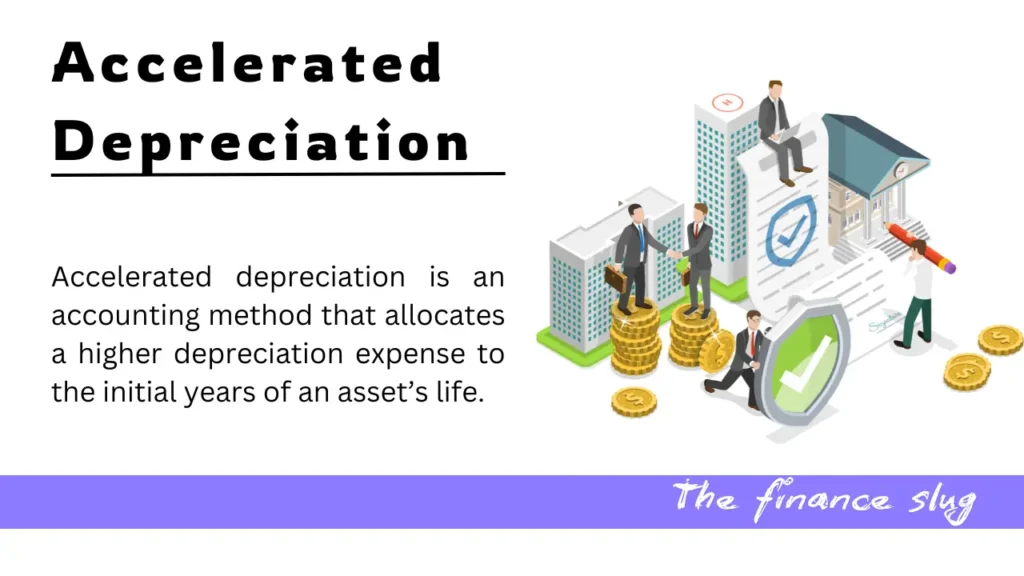Accelerated depreciation is a financial strategy that has become a cornerstone for businesses looking to optimize their tax liabilities and boost growth. By allowing companies to deduct larger portions of an asset’s cost early in its useful life, accelerated depreciation can provide significant cash flow advantages. In this article, we’ll delve into the concept, methods, benefits, and applications of accelerated depreciation, ensuring you have a clear understanding of its potential for your business.
What is Accelerated Depreciation?
Accelerated depreciation is an accounting method that allocates a higher depreciation expense to the initial years of an asset’s life. This approach contrasts with the straight-line depreciation method, where the asset’s cost is spread evenly over its useful life. Accelerated depreciation reflects the reality that many assets lose their value faster in their earlier years due to wear and tear or obsolescence.
For instance, consider a company purchasing manufacturing equipment for $100,000 with a useful life of 10 years. Using straight-line depreciation, the company would deduct $10,000 annually. However, with accelerated depreciation, it might deduct $20,000 in the first year, $15,000 in the second year, and progressively less in subsequent years. This front-loaded expense recognition provides immediate tax benefits, which can be crucial for businesses.
How Does Accelerated Depreciation Work?
Accelerated depreciation operates by assigning greater depreciation costs to the earlier years of an asset’s life. Two primary methods illustrate this concept:
- Double-Declining Balance (DDB): The double-declining balance method doubles the straight-line depreciation rate and applies it to the asset’s book value at the start of each year. For example, if an asset has a useful life of 5 years, the straight-line rate would be 20%, and the DDB rate would be 40%. This method provides a larger deduction initially, which gradually decreases as the book value of the asset declines. Businesses often use this method to match depreciation expenses with the higher revenue generated in the early years of the asset’s use.
- Sum-of-Years-Digits (SYD): The SYD method calculates depreciation using a fraction of the asset’s depreciable base, where the numerator decreases annually, and the denominator is the sum of the years in the asset’s useful life. For instance, an asset with a 5-year life will have a denominator of 15 (5 + 4 + 3 + 2 + 1). The first year’s depreciation would be 5/15 of the depreciable base, the second year’s 4/15, and so forth. This method provides a gradual reduction in depreciation expense, closely aligning with the asset’s decreasing productivity over time.
Both methods prioritize higher deductions early, aligning with the asset’s actual usage and value decline.
Benefits of Accelerated Depreciation
Accelerated depreciation offers numerous advantages that can transform a business’s financial health:
- Tax Savings: Recognizing larger depreciation expenses in the early years allows businesses to lower their taxable income. By doing so, they reduce the taxes owed during the initial years of an asset’s use. This approach is especially beneficial for businesses in growth phases, as it enables them to reinvest the saved funds into expansion or operational improvements, further boosting profitability.
- Improved Cash Flow: Accelerated depreciation reduces tax liabilities in the early years, providing businesses with increased cash flow. This financial relief can be critical for small or growing businesses that need to allocate resources effectively. Whether the additional funds are used for marketing, inventory, or paying down debt, improved cash flow supports overall business stability and growth.
- Alignment with Asset Usage: Many assets experience higher utility and wear in their initial years of operation. Accelerated depreciation aligns the depreciation expense with this pattern of usage, ensuring that financial statements accurately reflect the asset’s diminishing value. This approach provides a more realistic view of an asset’s contribution to revenue generation.
- Encouragement of Investment: Governments often use accelerated depreciation as an economic stimulus tool, encouraging businesses to invest in new equipment and technology. By front-loading the tax benefits, this method incentivizes companies to upgrade their operations, ultimately contributing to broader economic growth and innovation.
Accelerated Depreciation vs. Straight-Line Depreciation
While both methods aim to allocate an asset’s cost over its useful life, their approaches differ significantly. Accelerated depreciation provides front-loaded deductions, ideal for businesses needing immediate tax relief and cash flow improvement. Conversely, straight-line depreciation offers simplicity and consistency, suiting businesses with stable income levels that prefer predictable expense patterns.
For example, a technology startup investing in high-tech equipment may benefit more from accelerated depreciation, leveraging early tax savings to fund innovation and growth. In contrast, a well-established retail business with steady income might opt for straight-line depreciation to maintain balanced financial statements, ensuring stable financial metrics over time.
Accelerated Depreciation in Different Industries
Accelerated depreciation is a versatile tool applicable across various industries. Here are a few examples:
- Manufacturing: Manufacturing companies often invest heavily in machinery and equipment. Accelerated depreciation helps these businesses recover costs quickly, offsetting the significant upfront investments required to maintain competitiveness and efficiency.
- Technology: Tech startups frequently acquire rapidly depreciating assets, such as servers, software, and specialized hardware. By utilizing accelerated depreciation, these businesses can reduce tax liabilities early, freeing up cash to reinvest in research and development or scaling operations.
- Real Estate: Real estate property owners can take advantage of accelerated depreciation on improvements, such as HVAC systems, elevators, and other capital assets. This strategy helps them maximize tax savings while ensuring their properties remain modern and functional.
- Transportation: Fleet owners and logistics companies rely on vehicles and equipment that depreciate rapidly due to intensive use. Accelerated depreciation allows these businesses to align tax deductions with the heavy wear and tear experienced during the early years of the assets’ lifespan.
Tax Implications and Considerations
While accelerated depreciation offers compelling benefits, businesses must navigate its tax implications carefully. Here are key considerations:
- IRS Rules and Compliance: The IRS provides detailed guidelines on asset categories, useful lives, and approved depreciation methods. For example, the Modified Accelerated Cost Recovery System (MACRS) is a widely used framework in the U.S., categorizing assets into different classes with predefined recovery periods. Ensuring compliance with these rules is essential to avoid penalties and audits.
- Section 179 Deduction: Section 179 of the U.S. tax code allows businesses to deduct the full purchase price of qualifying equipment and software in the year they are acquired. This provision enhances tax savings by enabling businesses to write off significant investments immediately, reducing their taxable income.
- Bonus Depreciation: Bonus depreciation permits businesses to deduct a substantial percentage of an asset’s cost upfront. Recent legislative changes have set this percentage at 100% for specific assets, making it an attractive option for businesses looking to minimize tax liabilities while investing in new equipment or technology.
- Impact on Financial Statements: While accelerated depreciation reduces taxable income, it also lowers net income reported on financial statements. This reduction may affect profitability metrics used by investors and lenders to evaluate the business’s performance. Companies must balance the tax benefits with potential implications for financial reporting.
Accelerated Depreciation: Pros and Cons
Every financial strategy has its trade-offs. Here’s a balanced view:
Pros:
- Immediate tax relief allows businesses to reinvest in growth initiatives.
- Improved cash flow supports operational stability and strategic planning.
- Realistic alignment of depreciation with asset usage provides accurate financial representation.
- Encourages capital investment, fostering innovation and competitiveness.
Cons:
- Lower net income in the early years can affect financial performance metrics.
- Complexity in accounting and compliance requires specialized expertise.
- Reduced future deductions may limit tax-saving opportunities in later years.
Steps to Apply Accelerated Depreciation
Implementing accelerated depreciation requires careful planning. Follow these steps:
- Identify Eligible Assets: Review your asset portfolio to determine which assets qualify for accelerated depreciation under applicable tax laws. Common eligible assets include machinery, vehicles, and technology equipment.
- Choose the Appropriate Method: Evaluate your financial goals and select a method—such as DDB or SYD—that aligns with your objectives. Consider consulting with an accountant to make an informed decision.
- Use Depreciation Software: Invest in reliable accounting tools that can automate depreciation calculations, ensuring accuracy and compliance with tax regulations.
- Consult a Tax Professional: Work with a qualified tax advisor to navigate the complexities of accelerated depreciation and maximize the benefits while staying compliant with legal requirements.
Common Mistakes to Avoid
Businesses often encounter pitfalls when applying accelerated depreciation. Avoid these errors:
- Misclassifying Assets: Incorrectly categorizing assets can result in non-compliance, penalties, and missed tax-saving opportunities. Ensure accurate classification based on IRS guidelines.
- Neglecting Future Planning: Overemphasizing short-term tax savings without considering long-term financial implications can create challenges. Balance immediate benefits with future needs.
- Ignoring Updates to Tax Laws: Tax regulations governing depreciation methods change frequently. Stay informed to ensure compliance and maximize tax advantages.
FAQs About Accelerated Depreciation
Can all assets qualify for accelerated depreciation?
No, not all assets are eligible for accelerated depreciation. Eligibility depends on the asset type, its intended use, and the applicable tax regulations. Typically, tangible personal property such as machinery, equipment, and certain improvements qualify, while land and intangible assets like goodwill do not.
What is the difference between Section 179 and bonus depreciation?
Section 179 allows businesses to deduct the full cost of qualifying equipment or software in the year it is purchased, up to a specific limit. Bonus depreciation, on the other hand, permits businesses to deduct a substantial percentage (often 100% for qualifying assets) of an asset’s cost immediately, without an upper limit. Both methods aim to provide tax relief, but they differ in application and restrictions.
How does accelerated depreciation impact financial statements?
Accelerated depreciation lowers the taxable income in the early years of an asset’s life, which reduces taxes owed. However, it also decreases net income reported on financial statements, potentially affecting profitability metrics. Businesses must consider this impact when presenting financial performance to investors or lenders.
Can I switch from straight-line depreciation to accelerated depreciation?
Switching depreciation methods mid-stream is generally not allowed without IRS approval. Businesses must choose a depreciation method when the asset is placed in service and remain consistent unless a valid change request is submitted and approved.
Are there risks of using accelerated depreciation?
Yes, while accelerated depreciation provides immediate tax benefits, it may reduce deductions in later years, potentially increasing tax liabilities when the business might need savings. Additionally, improper application or non-compliance with tax laws can result in penalties or audits.
Is accelerated depreciation mandatory?
No, businesses can choose between straight-line depreciation, accelerated methods, or others like MACRS (Modified Accelerated Cost Recovery System) based on their financial strategy and tax planning needs. The decision often depends on cash flow requirements and long-term goals.
Article resources
- Corporate Finance Institute – Accelerated Depreciation
- Corporate Finance Institute – Types of Depreciation Method
- American Progress – tax-expenditure-of-the-week-accelerated-depreciation


